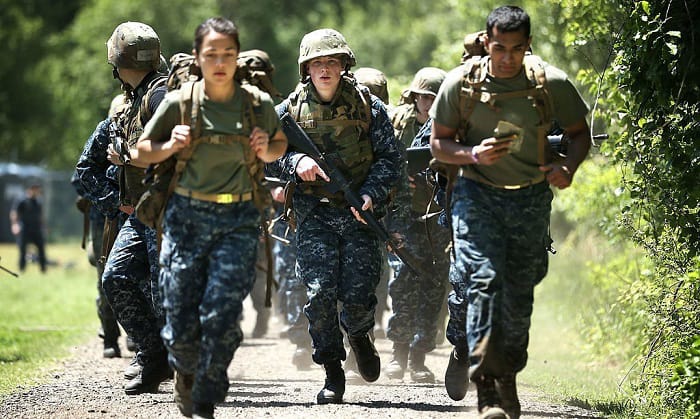One of the many military terms that you may come across when enlisting or simply looking at materials related to the military is ‘rucking.’ Do you know what is rucking in the military? It sounds like something complicated, but in reality, it isn’t. The answer will surely surprise you! Rucking is when a person in the military moves his or her gear in a backpack.
That’s all!
Ruck military can be walking with a gear-loaded backpack on a hike or moving quickly over rough terrain or while infiltrating a target. Thus, it can be referred to as a ruck hike or a ruck run. But the ruck definition of military is not the only aspect you should know. It is also worth knowing rucking benefits and details like military ruck weight.
So, continue reading to explore everything.
Table of Contents
- What Does Ruck Mean in the Military?
- What is the Pace for Rucking? Are There Standards?
- Tips to Ruck Properly and Effectively
- Tip 1: Walk first, then ruck
- Tip 2: Be comfortable with running first, then start rucking
- Tip 3: Strengthen your lower body and practice by lifting weights first, then go rucking
- Tip 4: Familiarize yourself with a vest first, then add actual weights later
- Tip 5: Become accustomed by incorporating rucking into daily routines
- Tip 6: Do not ruck daily when you are just starting to ruck
- Tip 7: Take care of your feet
- Tip 8: Make sure you have the right posture while you are rucking
- Tip 9: Trust the process and be patient
- Conclusion
What Does Ruck Mean in the Military?
Ruck or rucking, as said above, is when you move from one point to another with your gear in a backpack. It is done in the military, across all service branches, to help members get fit and stay fit. Therefore, it is sometimes called a rucking workout.
- Note: “Ruck” comes from “rucksack,” which is soldier language for a backpack.
The concept in play is the principle of progressive overload, which weight lifters use. In essence, the idea is that when you increase your load during an activity, like walking or running, you increase your muscles and cardiorespiratory system’s challenge.
Your body will be prompted to expend more energy, and at the same time, adapt to ease the challenge the next time. And, as a result, more calories and fat are burned and more strength and stamina are built for the rucker.
What is the Pace for Rucking? Are There Standards?
In the military, there are ruck marches, also known as loaded marches. This is most well known in the U.S. Army, so you will hear about it as ruck Army sometimes.
When you enlist, your first “encounter” with rucking (or ruck marches) will be in basic training. The goal is to ruck 12 miles (or 19 kilometers) in three hours. Usually, the load will be 35 pounds, but it also depends on the type of load.
- Note: The standard means a pace of 15 miles per mile average 12 mile ruck time. And Army 6 mile ruck march time is about 1.5 hours.
There are three types of load:
- Fighting Load: The service member must carry everything he or she needs to defeat the enemy. It can be up to 68.9 pounds, with items like:
- uniform and accessories (helmets, knee pads, etc.)
- equipment (aiming light, MREs, compass, first aid kit, etc.)
- weapons (grenades, bayonets, guns, etc.)
- Approach March Load: The service member must carry everything needed for direct contact with the enemy. The load must let a serviceman fight and sustain his or herself until there is resupply. This can reach 96.8 pounds (the cap is at 100 pounds).
- Emergency Approach March Load: The service member must carry any (heavy) items that cannot be moved by vehicle because of impassable terrain issues.
Another way to consider load is to use the 30% rule: carrying 30% of your bodyweight. For example:
- If you weigh 160 pounds, you carry 48 pounds
- If you weigh 180 pounds, you carry 54 pounds
- If you weigh 200 pounds, you carry 60 pounds
- If you weigh 220 pounds, you carry 66 pounds
Service members training for rucking add 5 to 10 pounds of weight every two to three weeks. They train in slow and quick marches with a cadence.
Tips to Ruck Properly and Effectively
Tip 1: Walk first, then ruck
Before you actually start rucking, you should walk. This ensures you become familiar with the bulk of the activity. In turn, you will easily and quickly get accustomed to rucking. It is advised that you walk every day for 30 minutes for a month or so.
Tip 2: Be comfortable with running first, then start rucking
If you are not yet comfortable with running, you will not be able to keep up when you actually go rucking. So, it is important to ensure you have a prior running foundation.
To do this, you should draw out and commit to a plan that builds up gradually. Here is an example of such plan:
Tip 3: Strengthen your lower body and practice by lifting weights first, then go rucking
It is easy to assume that rucking is easy. After all, you just need to walk or run while carrying a backpack! Unfortunately, it is easy peasy lemon squeezy.
Both your lower body and upper body should be prepared. In particular, your legs, hips, lower back, arms, and shoulders must be strong.
You can build this strength by doing exercises like lunges, squats, and deadlifts. Use barbells, kettlebells, dumbbells, or sandbags to assist you.
Tip 4: Familiarize yourself with a vest first, then add actual weights later
Rather than a backpack filled with gear on your very first time rucking, it is better to stimulate with a vest. Get a heavy or weight vest and practice rucking with it. Once you are comfortable, you can advance to an actual rucking gear. In that case, you can look for a military-issue one, such as
Tip 5: Become accustomed by incorporating rucking into daily routines
Rucking can be practiced in day to day routines. For example, when you are taking your dog for a stroll, it is possible to take a weighted backpack with you. You can also do it while you are commuting to the office on foot, and/or when you are running errands. This is a good idea if you do not have extra time to set aside for practicing.
Tip 6: Do not ruck daily when you are just starting to ruck
Despite the tip to blend rucking practice to daily routines, you should not ruck every single day, especially if you are new to rucking. You should limit rucking to 2 times a week, at most. Most training programs, including ruck in the Army programs, will ruck once or twice a week.
Note: You can still eventually progress to rucking daily, though.
Tip 7: Take care of your feet
This is particularly important for rucking long distances. Your feet will need to toughen up. Help them do that by walking barefoot on the sand once in a while or using extra cushioning accessories for regular training like fitted inserts. You can also wear two pairs of socks.
In this case, wear one thin pair and one thicker one (For example, wear a polyester or rayon-blend pair and a wool or cotton pair). Always check in with your feet and keep them from getting wet, too. Moist feet are more likely to get nasty blisters. If you do happen to get blisters:
- Before rucking, apply a bandage and petroleum jelly before putting on moisture-wicking socks
- After rucking, clean it and cover it with a bandage. Do NOT pop it
Another tip is to clip your toenails short and massage your feet. The latter is to ease inflammation as well as improve blood circulation.
Tip 8: Make sure you have the right posture while you are rucking
Many people overlook the importance of posture. But it definitely plays a role. Veterans can tell you that if you ruck with poor posture, the pain is much worse.
When carrying a lot of weight, we lean forward to counterbalance the weight as a reflex. This is also called the Trunk Lean. This posture, however, puts more stress on our lower back and abdominals, and so, accentuates the pain.
While rucking, you must keep your back straight, your shoulders rolled back, and your backpack as close to your back as possible.
Tip 9: Trust the process and be patient
Like anything else, trusting the process and being patient is necessary. Your body will not be able to ruck well (and without injuring itself) if you do not invest enough time and effort into preparing properly. Even when you think your body can handle it, progressing into rucking is always the better choice. According to military.com, a 10-mile ruck accomplishment can take a year or more!
Conclusion
As you have read, the answer to, “What is rucking in the military?” is moving from one place to another while carrying a weighted backpack. In the Army, the standard is 12 miles with at least 35 pounds for three hours. Hopefully, this has been helpful! Leave any thoughts or questions in the comments below. We love to hear from our readers.

For an ex-serviceman, it is a pleasure for me to continue my work in The Soldiers Project. This site is built with the target to help people who work in security jobs and other people to gear themselves with high-quality equipment. It is essential for many duties that they have the protection required to perform with safety.



